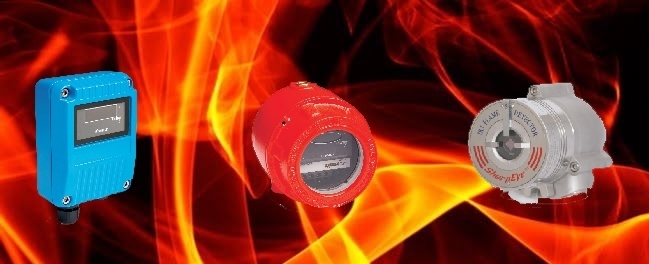
Flame detectors are installed to provide protection against the types of combustion where the first indication of fire is flame. Such types of fires are the fires caused by flammable, combustible liquids and gases and explosive substances. The sensors detect radiation emitted from the flame. The flame detectors respond more quickly than the smoke and heat detectors in flame-priority fires.
In the selection of the flame detectors, attention is paid to the type of flammable/ignition material, whether it is exposed to daylight and the ambient conditions according to the NEMA protection classification.
Basically, the flame detectors are grouped into the following main categories according to the wavelength they perceive in the flame:
The UV Flame Detectors detect radiation at wavelengths below an average of 300 nanometers (0.185-0.260 micrometers) and have relatively more rapid response times of up to 2-3 seconds. However, the point to be considered in the applications of the UV sensors that are hypersensitive to sunlight, lightning radiation, welding light, electric arc and halogen lamps is that the UV sensors exposed to such light and/or radiation source may cause unfavorable alarms or malfunctions. For this reason, the devices with UV detectors are not applied in a way that they are directly exposed to sunlight. They are more suitable for indoor use.
The IR Flame Detectors, on the other hand, detect radiation with an average wavelength of around 4-5 micrometers. Response times are approximately 4-5 seconds. They are more affected by the environmental conditions. Therefore, it has a much wider usage area.
The UV/IR Flame Detectors, which have both sensors, can detect more rapidly and relatively more accurately by combining both detection units. However, for the UV and IR Detectors, the conditions to be considered in the application are also applicable for these detectors. In the environments where the UV sensors can cause false alarms, the UV/IR sensors can offer more efficient solutions.
The Multispectrum IR Flame Detectors are the detectors with multiple sensors capable of detecting radiation at different wavelengths. They are especially used where the IR sensors can generate false alarms. They are produced in different types as two sensors (Double) or three sensors (Triple).
It provides the best solution in hydrocarbon (fuel oil, methane, etc.) derivative flames. In addition, it would be beneficial to use the multi-spectrum detectors against intermittent shading situations due to vehicle headlights, vehicle or human movement, and false alarms due to light fluctuations arising from the intermittent light penetration of the blades of the ventilation fans.
This type of flame detector detects by using CCD (charged couple device) imaging units, similar to the cameras in video imaging systems. They are the detectors that analyze and detect the image according to the fire algorithms in order to process the received image and to accurately detect the structural status of the flame. They detect without the need for UV or IR radiation in the flame. However, they cannot be used in case of the flames that are invisible to the eye like hydrogen. In addition, sensing weakness occurs in environments with fog and smoke.
Since they detect radiation, they do not need to be installed at ceiling level like smoke and heat detectors. They must be applied at the angles and distances specified by the manufacturer so that they can directly view the flame. Precautions should be taken against the accumulation of solid matter (oil, dust, etc.) on the surface of the detector sensor.
The manufacturer's installation instructions have to be observed, and the installation has to be carried out by considering whether the possible flame source is within the specified angle, the ambient operating temperature value, the IP protection class value, and the distance to the source.
In addition, almost all manufacturers have test lamps of various specifications and sizes for testing.
In addition to the typical characteristics and ambient conditions described above, the technical data of the manufacturers should be examined and an application that will generate at least one false alarm should be aimed. Whether the detectors that seem to be cost-effective meet your needs, your application area, the conditions of your environment, the manufacturers' technical values and application recommendations should be carefully evaluated. It should be considered that the products have been tested according to the test procedures specified in EN54-10 and/or NFPA72 and certified according to this test result.